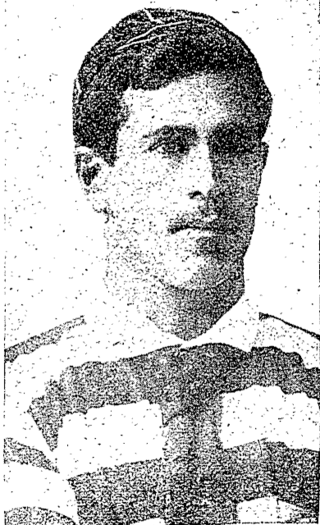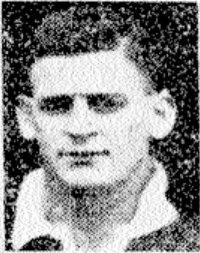
The Auckland Rugby League (ARL) is the governing body for the sport of rugby league in the Auckland Region of New Zealand. Founded in 1909, the ARL has played a central role in the development and promotion of rugby league in Auckland, contributing to the sport's rich history in the region.

William Thomas Wynyard was a New Zealand rugby football player who was part of the professional rugby league 1907–08 New Zealand rugby tour of Australia and Great Britain.
The 1910 New Zealand rugby league season was the third season of rugby league that had been played in New Zealand.
The 1911 New Zealand rugby league season was the fourth season of rugby league that had been played in New Zealand.
The 1914 New Zealand rugby league season was the seventh season of rugby league that had been played in New Zealand.

Arapeta Paurini Wharepapa, or Albert Asher as he was more commonly known, was a New Zealand dual-code international rugby union and professional rugby league footballer who played in the 1890s, 1900s, 1910s and 1920s. At representative level Asher played rugby union for New Zealand, North Island and Auckland playing on the Wing and played rugby league at representative level for Australasia, New Zealand, Auckland and the New Zealand Māori rugby league team. One of his brothers, Ernie, was also a rugby league international while another, John, became a Ngati Pukenga and Ngati Pikiao leader, and another brother, Thomas also played representative rugby for Tauranga. Katherine Te Rongokahira Parata was a sister.
Arthur Carlaw was a New Zealand rugby league player who played a role in the establishment of the sport in New Zealand and represented New Zealand.

Bill Davidson is a New Zealand rugby league footballer who represented New Zealand.
Stan Walters was a New Zealand rugby league footballer who represented New Zealand.

Charles Alexander Woolley is a New Zealand international rugby league footballer who represented New Zealand.
The 1911 Auckland Rugby League season was the second full organised club season in Auckland following the 1910 Auckland Rugby League season. City Rovers won the title again after winning it in the competitions inaugural year.

The 1918 Auckland Rugby League season was its 10th since its inception in 1909. It was again severely affected by the ongoing war with several hundred players serving overseas and 44 killed who were named in the annual report. North Shore Albions withdrew from the competition early in the season and on other occasions teams played short-handed. There was also a truncated representative program with only a trial match and one full Auckland representative match versus Canterbury, which was played at the Auckland Domain in front of 10,000 spectators.
The 1909 Auckland Rugby League season was the league's first ever official season. It celebrated its centenary in 2009. Four representative matches had been played in 1908 as players in Auckland attempted to showcase the new code to both Auckland residents and those elsewhere.
The North Shore Albions were a rugby league club based on the North Shore of Auckland in Devonport before moving to Bayswater at a later time. They formed in 1909 and folded in the early 2000s due to a lack of playing numbers. At the start of the 1920 season they were renamed Devonport United when they amalgamated with the Sunnyside club. It was proposed at the merger that they be known as North Shore Albions but Sunnyside objected and the name of Devonport United was chosen. In 1937, 17 years later at their annual general meeting they decided to revert to the name "North Shore Albions" as they had been commonly referred to as "shore" for many years. Chairman H. Mann made the proposal and it was adopted by the club. Aside from Northcote and Birkenhead Ramblers they were the only club on the North Shore at that time. They closed their doors in 2005. The only remaining club connected to them are the Northern Brothers who are based at Ngataringa Bay Sports Field. Their senior team is an amalgamation of East Coast Bays Barracudas and Glenfield Greyhounds but are based more in the North Shore Albions traditional area which includes the navy ground which has provided many players and teams over the years. The predominant colours are black and green which have been common colours of all the North Shore clubs over the decades.
Arthur Matthews (1889–?) played for the New Zealand rugby league team in 1919 on their tour of Australia. He was Kiwi number 117. He played in 3 tour matches but did not play in any tests as there were none played on this tour. He lived in Auckland and played for the Ponsonby United and North Shore Albions senior teams from 1915 to 1920.
Arthur Thompson "Tom" Haddon was a New Zealand rugby league player. He was Kiwi number 136 after playing two tests for New Zealand against Australia in 1919.

Allan Wilfred Seagar was a rugby league player who represented New Zealand in 1930, thus becoming New Zealand's 212th player. He also played for Auckland in 13 matches, and played from 1923 to 1941 for Devonport United, playing 159 matches. His brother George Seagar also represented New Zealand at rugby league; while his son Allan Herbert Seagar was a New Zealand champion swimmer, representing New Zealand at the 1962 and 1966 Commonwealth Games.
Edward Joseph Bennett was a New Zealand rugby league footballer. Bennett played in the second row position. He represented the New Zealand rugby league team in two test matches against England in 1920. In the process he became the 144th player to represent New Zealand. He also played for the Waiuku rugby club, and the Newton Rangers, and Grafton Athletic rugby league clubs. Bennett also represented the Auckland and North Island rugby league teams.
The Sunnyside League Football Club was a rugby league club based in Devonport, on the North Shore of Auckland, which existed from 1914 to 1920. They then amalgamated with the North Shore Albions club also based in Devonport. The Sunnyside area referred more specifically to the area to the west of the Navy base along to Stanley Point. The combined side became known as Devonport United. Sunnyside competed in the Auckland Rugby League lower grade competitions.
The Telegraph Messengers Club was a rugby league club in Auckland, New Zealand which existed from 1916 to 1919. They competed in the Auckland Rugby League lower grade competitions. They were initially affiliated to the Ponsonby United club before amalgamating with the Maritime Football Club during the 1920 season. They were composed of telegraph messengers for the Post and Telegraph organisation hence their name.









